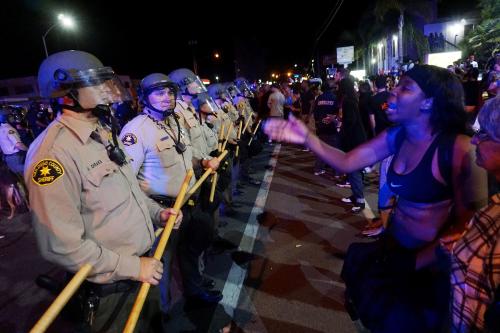On Sept. 26, 2019, Leonard Shand was shot and killed by 10 police officers from three distinct departments in Maryland: Hyattsville (6), Prince George’s County (3), and Mt. Rainer (1). For nearly 30 minutes prior, police officers attempted to use less lethal options to subdue Shand, a 49-year-old Black man who was talking loudly and holding knives in public outside of a shopping mall. Characterized as being in a “disoriented state,” Shand potentially suffered from a mental health crisis that exhibits similarities to some drug usage.
The city of Hyattsville held a community event and council meeting where elected officials offered condolences to the family. While some are calling the incident a justifiable shooting, others note that police officers may have been too far away to properly deploy less lethal options. On Oct. 8, community groups held a vigil at the homicide site for Shand’s family, who are demanding justice for what they consider to be an excessive use of force. If this incident supposedly represents a prototype of police de-escalation tactics, these policies and procedures clearly need to be revisited; bullets shattered apartment and business office windows, endangering onlookers who recorded the incident on social media. In addition to these concerns, I worry about the collective mental health of the local community as well as the police officers.
For the past several years, I have studied policing in America. My research team and I at the University of Maryland have performed dozens of police trainings, observed thousands of police officers, and conducted hundreds of interviews with officers in departments across the country. In addition to better understanding the huge disparities in the likelihood of Blacks versus whites being killed by police, we learned about the massive disparity in the likelihood of persons living with mental illness versus not coming into contact with police. Roughly 10% of calls for service involve someone with a diagnosed severe mental illness. People living with mental illness are more likely to experience use of force and be victims of officer-involved shootings. Yet, racial/ethnic minorities and low-income individuals are less likely to be diagnosed with a mental illness. Thus, their behavior may be categorized as noncompliance when it is actually about mental health.
Additionally, we learned about the effects that a “warrior culture” has on police officers. Police officers work and commute long hours, are often not paid enough to live in their work neighborhood—especially if policing in an urban area—and frequently work a substantial amount of overtime. We observed many instances of officers aiming to stay awake and alert during overnight or long shifts by taking energy pills. A survey of nearly 8,000 U.S. police officers found that nearly 80% report experiencing critical stress on the job, which led to recurring memories of incidents, anger issues, sleep problems, and/or family and relationship problems. For those struggling with critical stress, nearly 20% report coping with alcohol or drugs. Over 10% report having suicidal thoughts. Yet, 90% report a stigma associated with seeking therapy.
Why do police officers aim to avoid psychological services?
Despite most knowing about mental health services, only a small fraction use them. After any use-of-force incident, officers are mandated to meet with a psychologist. If the officer is not cleared for the field, they are put on desk duty. This determination is put in the officer’s personnel file, and it is often stigmatized as the officer’s inability to properly handle “real” police work. Considering that most large departments have in-house psychological services, these resources may be underutilized.
Who do police officers talk to about mental health?
In some forthcoming research, we discovered that officers are more likely to talk to clergy most truthfully about their issues and feelings, rather than family (officers cannot always share intimate details of their work to avoid conflicts of interest or to avoid worry) or other police (officers typically discuss police work in a masculine bravado manner to maintain reputation). Priests are likely confidants because officers perceive that they can be anonymously truthful.
What can be done about mental health preparedness and self-care for police officers?
First, my research center, The Lab for Applied Social Science Research, has developed a fully immersive, virtual-reality training program that allows officers to discern the differences between people living with mental illness or intellectual developmental disabilities, such as schizophrenia or autism, versus drug usage or noncompliance. If officers were trained to better respond to people with mental illness, Leonard Shand may still be alive today.
Second, police officers meeting with a psychologist should be normalized rather than stigmatized. Instead of just having to see a psychologist when a use-of-force event occurs, officers should have to meet with a psychologist at least quarterly. If police officers’ own mental health was better valued, the officers involved may have made different decisions.
Police officers are not robots. They are people. And humanity manifests itself in ways that can be consequential and problematic for victims, community members, and police officers themselves. If we want police to properly protect and serve our communities, we must give them proper resources to protect and serve their own mental health.
The Brookings Institution is committed to quality, independence, and impact.
We are supported by a diverse array of funders. In line with our values and policies, each Brookings publication represents the sole views of its author(s).







Commentary
What does the shooting of Leonard Shand tell us about the mental health of civilians and police?
October 16, 2019